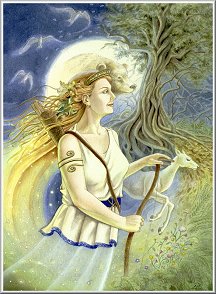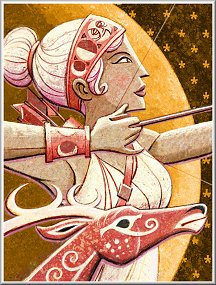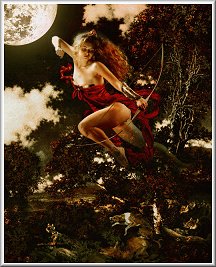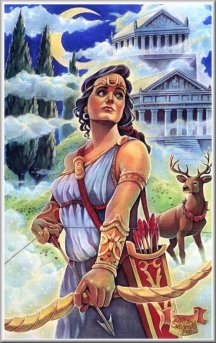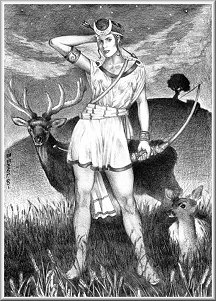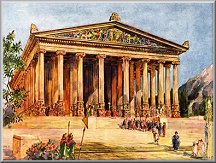MYTH MAN'S AWARD-WINNING HOMEWORK HELP
ARTEMIS, GODDESS OF THE HUNT
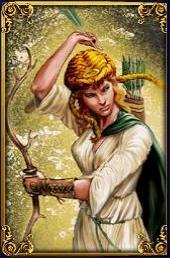
LATIN - DIANA
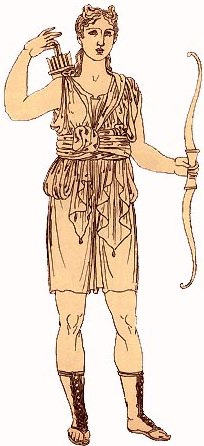
Artemis and her twin brother Apollo were the children of Zeus and Leto, who was
the daughter of the Titans Phoebe and Coeus. They were born on the island of
Delos because Hera, jealous of her husband's love for the woman, had refused
Leto to give birth on neither the mainland nor an island out at sea. The only
place safe enough to give birth was Delos, because Delos was said to be a
floating island.
Some versions of the twins' birth state that Artemis was born one day before
Apollo, with that birth having taken place on the island of Ortygia. Then the
very next day, newborn Artemis helped her mother Leto to cross to the island of
Delos, and even aided Leto with the delivery of Apollo. Either version may be
considered accurate, depending on the source relied upon.
Like her brother, she has the power to send plagues
or sudden death among mortals, and also to heal those who please her.
Artemis loves to hunt and she is the lady of the forest and all the wild
things, as well as the Huntsman-in-chief to the gods, an unusual
position for a woman. She protects little children and all suckling
animals.
Armed with the weapons specially crafted for her by
the three Cyclopes, as ordered by Zeus (see sidebar at left) ,
Artemis next went to the region of Arcadia and asked the god Pan for
three lop-eared hounds, two parti-colored and one spotted, capable of
dragging live lions back to their mistress. Pan also gifted Artemis
seven swift hounds from Sparta
She captured alive four horned hinds and harnessed
them to a golden chariot with golden bits. That was her ride. The first
four times she tried the silver bow that the Cyclopes had made for her,
Artemis sharpened her unerring aim by taking shots at two trees, a wild
beast and a city of unjust men, whom she cut down mercilessly.
She is one of the three virgin goddesses along with
Athena and Hestia. When Artemis was still only three years old and on
her father Zeus' knee, he asked her what presents she would like. She
didn't hesitate to ask this of the King of the Olympians:
"Pray give me eternal virginity; as many names as my brother Apollo; a
bow and arrows like his; the office of bringing light; a saffron hunting
tunic with a red hem reaching to my knees; sixty young ocean nymphs from
Amnisus in Crete, to take care of my buskins and feed my hounds when I
am not out shooting; all the mountains in the world; and, lastly, any
city you care to choose for me, but one will be enough, because I intend
to live on mountains most of the time. Unfortunately, women in labor
will often be invoking me, since my mother Leto carried and bore me
without pains, and the Fates have therefore made me patroness of
child-birth."
Callimachus: Hymn
to Artemis
Hence, she also presides over childbirth; as stated
above, this goes back to the fact that she did not cause her mother any
pain when she was born.
As always in Greek Mythology, she also had her dark
side, showing her as fierce and vengeful warrior. For example, although
she is the protector of the young, she kept the Greek Fleet from sailing
to Troy, until Iphigenia, a royal maiden, daughter of the Commander in
Chief Agamemnon was sacrificed to her. All because the Greek soldiers
killed one of her creatures, a hare, together with her young. On the
other hand, when women died a quick and painless death, they were said
to have been slain by Artemis’ silver arrows.
Artemis was vindictive and there were many who
suffered from her anger. One of her actions was to join Apollo in
killing the children on Niobe. Artemis took part in the battle against
the Giants, where she killed Gration. She also destroyed the Aloadae and
is said to have killed the monster Bouphagus. Other victims of Artemis
included Orion and Actaeon, who had seen her bathing in the nude and was
turned by her into a stag, only to be torn to shreds by his own dogs.
Artemis was also associated with the moon, and called
Phoebe and Selene (Luna in Latin), neither of which name originally
belonged to her. Phoebe was a Titan, one of the elder gods. So was
Selene, a moon-goddess and sister of Helios, the sun-god often confused
with Artemis’ brother, Apollo. She was called The Maiden of the Silver
Bow and her silver bow indeed stood for the new moon.
In the later poems Artemis became associated with
another goddess, Hecate, the
dark and awful goddess of the lower world. Hecate was the Goddess of the
Dark of the Moon, the black nights when the moon is hidden. She was
associated with deeds of darkness, the Goddess of the Crossways, which
were held to be ghostly places of evil magic and awful divinity. Thus
she became "the goddess with three forms," Selene in the sky, Artemis on
earth and Hecate in the lower world as well as in the world above, when
it is wrapped in darkness. In Artemis is shown most vividly the
uncertainty between good and evil which exists in every god. Ironically,
this contrast is least apparent in her brother, the God of Light,
Apollo.
Artemis was held in honor in all the wild and
mountainous areas of Greece, in Arcadia and in the country of Sparta, in
Laconia on Mount Taygetus and in Elis. Her most famous shrine was at
Ephesus. Artemis absorbed some cults that involved human sacrifice, such
as that practiced in Tauris.
Where Apollo was considered the sun, she was
associated with the moon. Ephesus is located on the Aegean coast of
Turkey, what the ancients called Asia Minor, about 200 miles south of
Ancient Troy. Ephesus controlled the narrow entrance from the Aegean to
a large lake and the surrounding beautiful and fertile mountains and
hills. Ephesus was a rich and important settlement for at least eight
thousand years - all of recorded history - and before.
When the
Romans succeeded the Greeks, the worship remained unchanged except in
name; the Greek Artemis became the Roman Diana.
The Temple of Artemis no longer stands. The wonder of
the ancient world was built after the death of Alexander the Great,
about 320 B.C., and stood for a thousand years, only to be destroyed by
the Goths, a Germanic people, who swept across Europe and across the
Bosporus into Asia Minor. The marble from the temple was later used in
the construction of local buildings, as well as the important church of
St. Sofia in Istanbul.
The wonder of the world was the fourth temple to
Artemis to be built on the same site. Ivory and gold votive objects have
been excavated from beneath the foundations of the first of these
temples, indicating the likelihood of even earlier worship and earlier
structures. These foundations now lie well below the water table, making
further excavation very difficult. The third temple was also very grand,
financed in part by the king of Lydia, Croesus.
A temple column with a
inscription from Croesus (whose wealth was the proverbial "rich as
Croesus") is now in the British Museum in London. This third temple was
burned down by a madman, Eristratos, on the night of Alexander the
Great's birth. Local legend had it that Artemis, being in attendance at
Alexander's birth, was unable to defend her temple.


[HOME] [MYTHOLOGY'S
EFFECTS ON MODERN SOCIETY][OLYMPIANS]
[GALLERY] [MAJOR
GODS] [MINOR
GODS] [HEROES]
[CONTACT]
[LOVE STORIES]
[MYTH OF THE
MONTH] [FUN
STUFF] [CREATURES]

